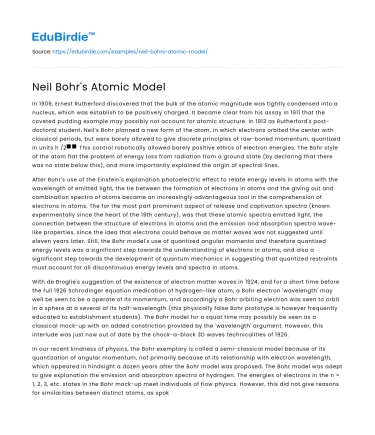In 1909, Ernest Rutherford discovered that the bulk of the atomic magnitude was tightly condensed into a nucleus, which was establish to be positively charged. It became clear from his assay in 1911 that the coveted pudding example may possibly not account for atomic structure. In 1913 as Rutherford's post-doctoral student, Neil’s Bohr planned a new form of the atom, in which electrons orbited the center with classical periods, but were barely allowed to give discrete principles of raw-boned momentum, quantized in units h /2π. This control robotically allowed barely positive ethics of electron energies. The Bohr style of the atom flat the problem of energy loss from radiation from a ground state (by declaring that there was no state below this), and more importantly explained the origin of spectral lines.
After Bohr's use of the Einstein's explanation photoelectric effect to relate energy levels in atoms with the wavelength of emitted light, the tie between the formation of electrons in atoms and the giving out and combination spectra of atoms became an increasingly advantageous tool in the comprehension of electrons in atoms. The for the most part prominent aspect of release and captivation spectra (known experimentally since the heart of the 19th century), was that these atomic spectra emitted light, the connection between the structure of electrons in atoms and the emission and absorption spectra wave-like properties, since the idea that electrons could behave as matter waves was not suggested until eleven years later. Still, the Bohr model's use of quantized angular momenta and therefore quantized energy levels was a significant step towards the understanding of electrons in atoms, and also a significant step towards the development of quantum mechanics in suggesting that quantized restraints must account for all discontinuous energy levels and spectra in atoms.
Save your time!
We can take care of your essay
- Proper editing and formatting
- Free revision, title page, and bibliography
- Flexible prices and money-back guarantee
With de Broglie's suggestion of the existence of electron matter waves in 1924, and for a short time before the full 1926 Schrodinger equation medication of hydrogen-like atom, a Bohr electron 'wavelength' may well be seen to be a operate of its momentum, and accordingly a Bohr orbiting electron was seen to orbit in a sphere at a several of its half-wavelength (this physically false Bohr prototype is however frequently educated to establishment students). The Bohr model for a squat time may possibly be seen as a classical mock-up with an added constriction provided by the 'wavelength' argument. However, this interlude was just now out of date by the chock-a-block 3D waves technicalities of 1926.
In our recent kindness of physics, the Bohr exemplary is called a semi-classical model because of its quantization of angular momentum, not primarily because of its relationship with electron wavelength, which appeared in hindsight a dozen years after the Bohr model was proposed. The Bohr model was adept to give explanation the emission and absorption spectra of hydrogen. The energies of electrons in the n = 1, 2, 3, etc. states in the Bohr mock-up meet individuals of flow physics. However, this did not give reasons for similarities between distinct atoms, as spoken by the periodic table, such as the detail that helium (two electrons), neon (10 electrons), and argon (18 electrons) exhibit similar chemical inertness. Modern quantum mechanics explains this in terms of electron shells and subshells which can each hold a number of electrons determined by the Pauli Exclusion Principle. Thus, the n = 1 state can hold one or two electrons, while the n = 2 state can hold up to eight electrons in 2s and 2p subshells. In helium, all n = 1 states are fully occupied; the same is true for n = 1 and n = 2 in neon. In argon, the 3s and 3p subshells are similarly fully occupied by eight electrons; quantum mechanics also allows a 3d subshell but this is at higher energy than the 3s and 3p in argon (contrary to the situation in the hydrogen atom) and remains empty.






 Stuck on your essay?
Stuck on your essay?

